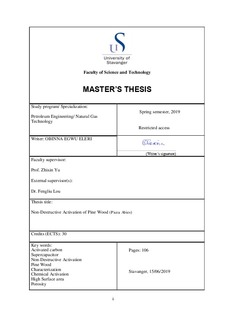| dc.contributor.advisor | Zhixin, Yu | |
| dc.contributor.advisor | Fengliu, Lou | |
| dc.contributor.author | Eleri, Obinna | |
| dc.date.accessioned | 2020-03-05T14:35:24Z | |
| dc.date.available | 2020-03-05T14:35:24Z | |
| dc.date.issued | 2019-06-15 | |
| dc.identifier.uri | http://hdl.handle.net/11250/2645571 | |
| dc.description | Master's thesis in Petroleum Engineering | nb_NO |
| dc.description.abstract | This study investigates a novel technique of non-destructive activation(NDA) of Pine wood (Picea Abies) via the aid of chemical activation in the presence of a metal additive. Two additives (Cu and Al) were considered in the process with their ratios varied at selected amounts from 0.25,0.5, 1 and 2 to the wood char. Activation temperatures of 750 oC and 850 oC were utilized in combination with KOH impregnation ratios of 2 and 4 for the various additive ratios. The effect of increase in temperature, impregnation ratio and additive ratio were compared in relation to changes in the specific surface area as a measure of level of activation. Blank samples without additives at the two temperature levels and impregnation ratios were also synthesized and compared to the non-destructively activated carbon. Nitrogen adsorption, X-ray diffraction, Scanning Electron Microscopy/ EDS characterizations were carried out on the various activated carbons produced. An impregnation ratio of 4, in combination with activation temperature of 850 oC was found to be the optimum condition for high surface area. Cu additive was more successful in the NDA with additive intensity of (Char:Cu:KOH) 1:1:4 at 850 oC and 1:0.5;4 at 750 oC considered as the optimum intensity for high specific surface area. In general, activated carbon with very high specific surface areas up to 3350 m2/g were obtained. Electrodes and coin cells were fabricated with some of the samples and compared to those fabricated with commercial activated carbon YP80F. Ohmic resistance, self-discharge and specific capacitance were measured for the Blank, NDA with Al and commercial activated carbon and compared. The blank samples exhibited highest specific capacitance of 156F/g @ 0.056 mA/cm2 and 161 F/g @ 2.83 mA/cm2 but the NDA with Al had the lowest ohmic resistance of 0.13 Ωcm2. The blank experiment and NDA sample with Al had better properties in terms of higher specific capacitance and lower self-discharge rates than the commercial activated carbon compared YP80F with similar loading. | nb_NO |
| dc.language.iso | eng | nb_NO |
| dc.relation.ispartofseries | Masteroppgave/UIS-TN-IEP/2019; | |
| dc.rights | Attribution-NonCommercial-NoDerivatives 4.0 Internasjonal | * |
| dc.rights.uri | http://creativecommons.org/licenses/by-nc-nd/4.0/deed.no | * |
| dc.subject | petroleumsteknologi | nb_NO |
| dc.subject | petroleum engineering | nb_NO |
| dc.subject | petroleum technology | nb_NO |
| dc.subject | water weakening | nb_NO |
| dc.title | Non-Destructive Activation of Pine Wood (Picea Abies) | nb_NO |
| dc.type | Master thesis | nb_NO |
| dc.subject.nsi | VDP::Technology: 500::Rock and petroleum disciplines: 510::Petroleum engineering: 512 | nb_NO |

